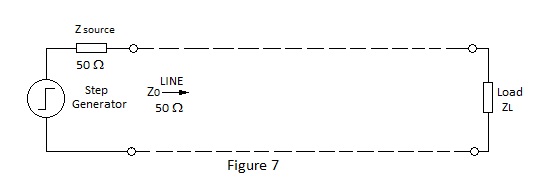
Transmission Lines
1. Introduction
In the digital age electronics engineers and technicians, other than those specialising in communications, often have a hazy understanding of transmission lines.
The following is an attempt to describe the properties and use of lines for the transmission of signals from one point to another with reference to their use for pulse shaping and delay.
For the mathematically inclined, application to ‘A Level’ standard is required for the derivation of some parameters.
Any arrangement of flow and return conductors with a fixed spacial relationship (twin feeder, coaxial cable etc.) constitutes a transmission line.
2. Characteristic Impedance Z0
Although aware of its significance, some find the concept of characteristic impedance, e.g. for a coaxial cable, difficult to relate to.
That the conductors have resistance and inter-conductor capacitance proportional to their length does not square with the concept that a line presents constant impedance to an alternating current irrespective of its length and the frequency of the current.
This is because the influence of the less apparent parameters, series inductance and shunt conductance is more difficult to appreciate. The situation is not helped by the classic definitions of characteristic impedance Z0:
a) Characteristic impedance is defined as the impedance presented to a signal source by a line of infinite length. As the length is infinite the attenuation is infinite so the termination of such a line has no effect upon the impedance presented by the line.
b) Characteristic impedance is defined as the impedance presented to a signal source by a line of finite length when terminated by an impedance which is equal to its characteristic impedance. This condition is that for maximum power transfer and a line so terminated is referred to as “matched” or correctly terminated.
To demonstrate the property of characteristic impedance it is necessary to consider the four parameters of a transmission line:
a) R = resistance per loop unit length W (Ohms)
b) L = inductance per loop unit length H (Henrys)
c) C= capacitance per unit length F (Farads)
d) G = shunt conductance per unit length S (Siemens)
Note…
L incorporates the self inductance of both conductors and their mutual inductance (L + L + 2M) and G incorporates insulation leakage, dielectric losses and any external losses.
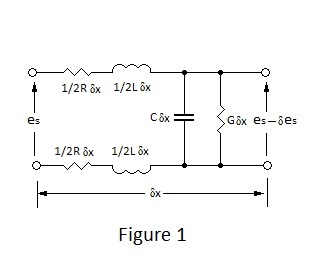
A line assembled from discrete components can be used to demonstrate the properties of lines or to delay signals. However because the parameters are distributed it is not justifiable to represent a finite line by lumped parameters because there can be no valid criterion for their relative positions.
If however a section of infinitesimal length dx is considered, the attenuation is negligible and the layout is immaterial so that assumed in Figure 1 is acceptable.
Mesh analysis of the assumed element of line may be simplified by placing the series components in one conductor and rearranging it as the symmetrical ‘T’ section depicted in Figure 2. The equivalence of this T section must be qualified as referring only to the input and output pairs of terminals but this is not a practical problem.
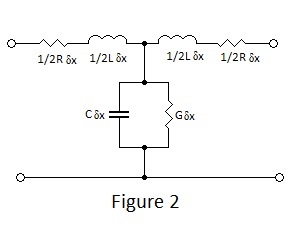
Returning to a hypothetical finite line, assume that any length of line can be represented by the equivalent symmetrical T network shown in Figure 3. If this network is to behave like a line it must satisfy definition b) i.e. it must present characteristic impedance Z0 to a signal source when the terminating load is equal to Z0. |
|
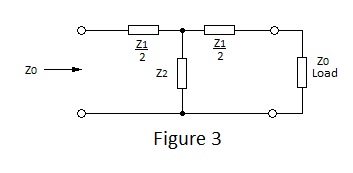 |
|
Analysing this circuit to determine a value for Z0 which satisfies definition b) in terms of the chosen circuit parameters. We find that: |
|
 |
|
This simple formula is very important as it may be used to calculate the characteristic impedance of any T or Π network for matching purposes; this includes simple attenuators and filters. It does not however give enough information to determine the T network components to give equivalence to a given line. |
|
Open Circuit
|
|
Short Circuit
|
|
 |
|
This formula may be applied to any transmission line and in fact to any four terminal passive network. |
|
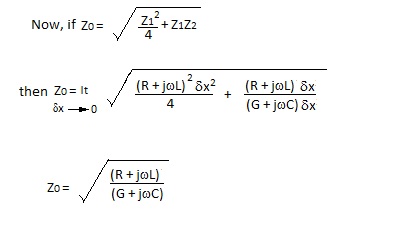 |
|
For practical lines, eg. good quality coaxial cable or twin feeder at frequencies in a range from kHz to GHz, R and G are small compared to the reactance elements so Z0 approximates to: |
|
 |
|
Free space acts a transmission line for radio communication and the equivalent formula applies to free space: |
|
 |
|
 |
|
Propogation Coefficient γ |
|
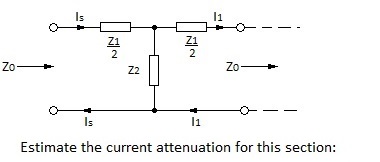 |
|
 |
|
And can therefore be represented as an exponential with a complex index ( e exp γ) where γ is complex. γ is defined as the “propogation coefficient”. |
|
 |
|
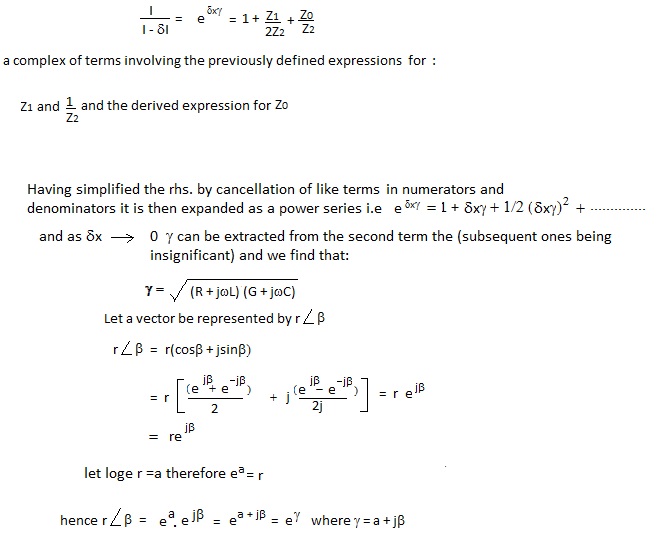 |
|
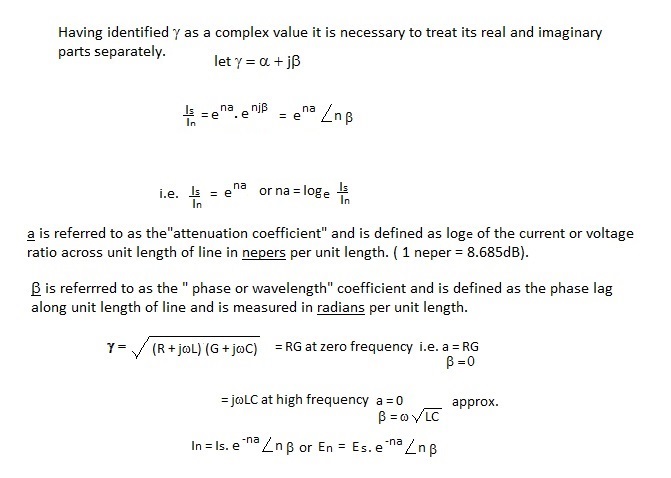 |
|
Travelling Waves The wavelength λ is the distance along the line over which the signal phase shifts by one cycle (2π radians). |
|
 |
|
Standing Waves With the extremes of open circuit or short circuit termination, no energy can be absorbed and all of the incident energy is reflected. If then the attenuation of the line is negligible, the reflected wave will cancel the incident wave at the nodal points. A short circuit cannot accept a voltage wave and the voltage wave is reflected with phase reversal to satisfy the condition of a node at the termination. Assuming the impedance of the signal source is the same as Z0 (i.e. matched at the input), the shorted termination demands twice the incident current which clearly the line cannot supply a full amplitude current wave is reflected without phase reversal; producing a node ¼ of a wavelength backfrom the load. At an open circuit the current wave is reflected with phase reversal and the voltage wave without phase reversal. Thus with both open and short circuit terminations the current and voltage are in phase quadrature so the impedance presented by ¼ wavelengths of ‘lossless’ line or multiples thereof is a pure reactance. Change of frequency for a fixed length of line has the effect as change of length for a fixed frequency and it can be seen from Figures 4 and 5 that, if the frequency of the signal source varies about the reference frequency for a given ¼ λ short circuit or open circuit stub, the stub behaves in a manner comparable with a resonant circuit. Thus an odd order 1/4λ short circuit stub has a response similar to that of a parallel tuned circuit, as does an even order ¼ λ open circuit stub. Correspondingly an even order short circuit or an odd order open circuit responds in asimilar manner to a series resonant circuit. |
|
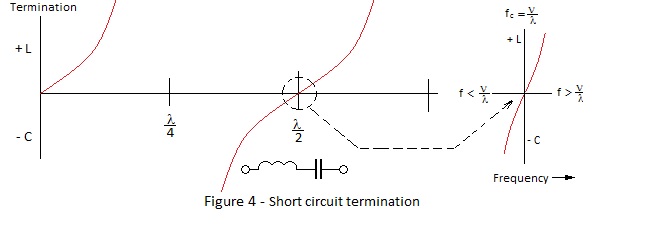 |
|
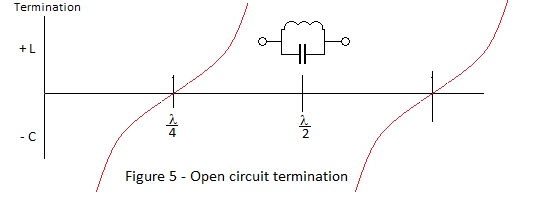 |
|
Pulse Response |
|
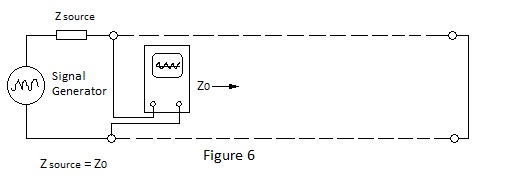 |
|
To illustrate some of the pulse properties of lines, it is perhaps worthwhile to reason through examples involving the application of voltage step functions to incorrectly terminated lines.
|
|
At the Ein step the voltage at the line input terminals Vin must be Ein/2 because the generator can only see the line impedance Z0 and is ‘unaware’ that the line is incorrectly terminated until the incident travelling wave has reached the termination and the reflected travelling wave has returned. |
|
| Once this has happened the input voltage Vin must equal Einx ZL/(ZS + ZL) as all that has been done is to connect a direct voltage source to a potential divider formed by ZL and ZS. What happens therefore during the time that the transmission line is active and transmitting energy in one direction or the other? ZL < Z0 In this case there will be a shortfall of current available to the load of Vin/ZL - Vin/Z0 The currentwhich would flow in the load for an emf. of Vin minus the incident current. This additional current may be considered to flow back to the input without phase reversal so as to augment the input current to reduce Vin by the additional voltdrop across Zs..
|
|
ZL > Z0 In this case there will be an excess of current available to the load of Vin/Z0 - Vin/Vin/ZL. The load will accept a proportion of this excess current, the additonal current (Iadd) received this way being given by: Iadd = Iexc x Z0/(Z0 + ZL) Where Iexc is the current excess. |
|
Step and Pulse Responses for Short Circuit and Open Circuit Lines Figures 8 and 9 depict the useful properties of short circuited and open circuited delay lines |
|
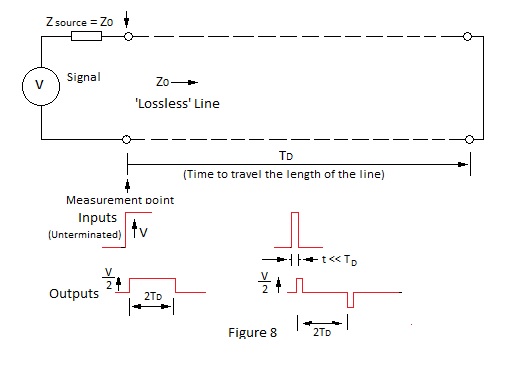 |
|
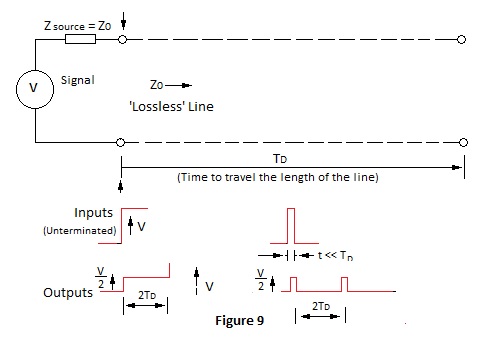 |
|
The Smith Chart |
|
| Thanks for reading |


